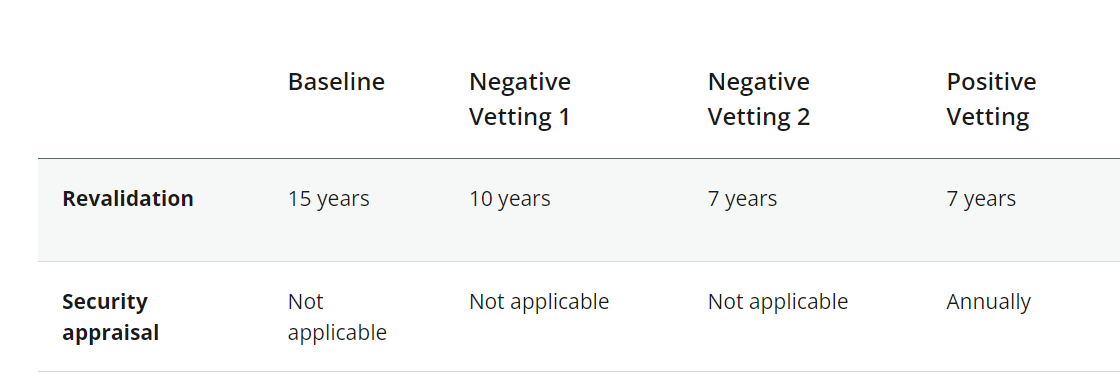
Interested in a career in Federal Government? For many roles, to even be considered, you will need to hold a security clearance.
Why? Because government agencies deal with varying levels of sensitive and confidential information that can only be accessed by security-cleared workers.
In this blog, we provide a guide to help you understand what security clearances are and how to acquire and maintain them.
The four levels of security clearance:
The level of security clearance you need for a government role is determined by the amount of access you’ll need to sensitive information. The higher the sensitivity, the higher clearance you will need.
There are four security clearance levels in the Australian Government:
- Baseline Clearance – Access to protected information
- Negative Vetting Level 1 (NV1) – Access to secret information
- Negative Vetting Level 2 (NV2) – Access to top-secret information
- Positive Vetting (PV) – Access to top-secret information when NV2 clearance isn’t sufficient
According to Government data, over 49,000 new security clearances were completed in 2019-20, and over 400,000 active clearances were maintained in the same year.
So, the key question is, how do you join this exclusive talent pool?
How to apply for security clearance?
The Federal Government, like any business, wants the best talent. But, unlike commercial businesses, they demand additional levels of certainty pertaining to your eligibility and suitability to safeguard classified government data.
To be eligible, you need to be an Australian citizen. You also need to be sponsored by an Australian Government department or agency in order to apply for a security clearance, which happens if you win a role that requires a security clearance and if the agency offers to sponsor you. It is not possible to obtain a security clearance without a sponsoring entity. Once you’ve ticked these boxes, you’ll then need to be vetted by the Australian Government Security Vetting Agency (AGSVA).
This vetting assessment is extensive and probes most aspects of your life. This includes your identity, citizenship, background (between 5-10 years), digital footprint, referees, qualifications, education history, criminal history, and financial history. Furthermore, you may also have to undergo additional security interviews and psychological assessments to prove your fit for clearance in the eyes of the government. The higher the clearance, the more hoops you’ll have to jump through.
Another important consideration is that obtaining a security clearance can take time. This isn’t due to the length of the vetting process, but often a large backlog of applications to the AGSVA. This means a baseline clearance can take 3 months, and an NV1 clearance can take up to six months.
How to maintain your clearance?
Security clearances aren’t forever. Irrespective of your clearance level, like a driver’s license or a passport, at some point, it’ll need to be renewed.
Revalidation ranges from 7-15 years depending on your level of clearance. Additionally, you must be in a job that requires clearance at your renewal date and be working at an entity willing to sponsor the renewal. If this isn’t the case, the clearance will be canceled. Such measures ensure that only the most relevant talent maintains security clearance to work in sensitive public sector roles.
This means If you want a career within the Federal Government, chances are you’ll need to obtain a security clearance. If you meet the criteria and are deemed suitable in the eyes of the government, such clearance will give you access to a wide range of job opportunities across the government sector. At Ignite, we are specialists in recruitment at all levels of Government and have extensive experience connecting security-cleared candidates with our large network of Federal and State Government clients. For more information, visit our website and contact us today.
Australian Security Clearance for Government Jobs: FAQs Answered
Get answers to frequently asked questions about Australian security clearance for government jobs. Learn about the duration of the clearance process, eligibility for non-citizens, the necessity of clearances for different roles, implications of failing to obtain clearance, transferability of clearances, renewal procedures, and the impact of criminal records on eligibility.
How long does it take to obtain an Australian security clearance?
The duration of the security clearance process can vary depending on several factors, including the level of clearance sought and the complexity of the individual’s background. Generally, it can take anywhere from a few weeks to several months to complete the process.
Can non-citizens obtain an Australian security clearance?
No, security clearances in Australia are only granted to Australian citizens. This requirement ensures loyalty, allegiance, and a commitment to the country’s interests.
Do I need a security clearance for all government jobs in Australia?
Not all government jobs require a security clearance. The need for a security clearance depends on the nature of the role and the level of access to classified information or sensitive assets involved. Positions with higher levels of sensitivity are more likely to require a security clearance.
What happens if I fail to obtain a security clearance?
If an individual fails to obtain a security clearance, they may not be eligible for certain government positions that require access to classified information. However, there are often alternative roles within the government that do not require a clearance and may still be available for consideration.
Are security clearances renewable?
Yes, security clearances in Australia are subject to periodic reviews and renewals. The frequency of these reviews depends on the level of clearance granted. Regular reviews ensure that individuals continue to meet the necessary standards of integrity and trustworthiness.

Can having a criminal record disqualify me from obtaining a security clearance?
Not all criminal records automatically disqualify an individual from obtaining a security clearance. Each case is evaluated on its merits, considering factors such as the nature of the offense, the time elapsed since the incident, and evidence of rehabilitation. Transparency and honesty about one’s criminal history are crucial during the clearance process.
What factors can lead to a security clearance being denied?
Security clearances may be denied due to factors such as significant criminal history, associations with individuals involved in criminal or extremist activities, foreign connections that raise concerns about loyalty, or a pattern of dishonesty or untrustworthiness.
Can having a bad credit history affect my chances of obtaining a security clearance?
A: While having a bad credit history alone may not automatically disqualify you, it can raise concerns regarding financial vulnerability and susceptibility to bribery or coercion. The extent to which it affects your clearance application will depend on the overall assessment of your character, trustworthiness, and ability to manage financial responsibilities.
Are there any specific educational or professional qualifications required for security clearances?
Educational or professional qualifications are not direct requirements for security clearances. However, certain government roles that require clearances may have specific educational or professional prerequisites. The clearance process primarily focuses on an individual’s character, integrity, and suitability for handling classified information.
Can personal relationships or associations impact the security clearance process?
Personal relationships and associations can be considered during the security clearance process. The purpose is to identify any potential risks associated with an individual’s close connections, such as family members or partners, who may have conflicting loyalties or associations with individuals or organizations that pose a security risk.
Can past drug use affect the security clearance process?
Past drug use can be a concern during the security clearance process, as it raises questions about an individual’s judgment, reliability, and susceptibility to compromise. However, each case is evaluated on its merits, considering factors such as the frequency, recency, and circumstances surrounding the drug use, as well as evidence of rehabilitation.

Leave a Comment
We’d love to hear from you! Share your thoughts or ask a question in the form below.